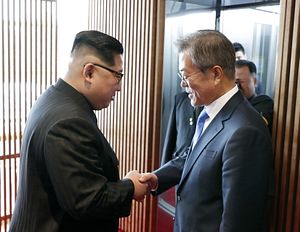If at the beginning of this year, someone had told you that in September, South Korean President Moon Jae-in would be meeting his North Korean counterpart, Kim Jong Un, for the fifth-ever inter-Korean summit, it might have seemed far-fetched. But this is indeed where the remarkable diplomatic momentum of 2018 is heading.
Kim and Moon will meet for their third meeting—recall that their first meeting in April was the third overall inter-Korean summit—in September. The meeting was announced in a press statement following joint high-level inter-Korean talks on the North Korean side of the Joint Security Area in Panmunjom, the site of the April 27 summit. “The South and the North agreed to hold the scheduled Inter-Korean Summit within September in Pyongyang,” the statement noted.
The two leaders have not met since an impromptu encounter in the Demilitarized Zone separating the two Koreas in the immediate aftermath of U.S. President Donald J. Trump’s decision to call off a then-scheduled summit between himself and Kim. After the inter-Korean meeting, diplomacy found its way back on track and Trump met Kim on June 12.
The upcoming inter-Korean summit may be more difficult for Moon than the first two encounters with Kim. The two leaders will take stock of the implementation of the April 27 declaration they jointly made at Panmunjom. While much Western commentary has focused on section 3, subsection 4 of that agreement—the clause focused on the “complete denuclearization of the Korean Peninsula”—the bulk of the Panmunjom declaration makes reference to inter-Korean activities and rapprochement.
Since the April meeting—and even in the months before, beginning with the initial inter-Korean diplomacy this year during the PyeongChang Winter Olympics—inter-Korean activities have intensified. Everything from sports exchanges to military-military confidence-building to even magician exchanges have taken place. Inter-Korean family reunions are scheduled for this month.
South Korea, in particular, has been keen to push on with any and all kinds of inter-Korean activities except those prohibited by United Nations Security Council sanctions. After North Korea’s unprecedented pace of ballistic missile and nuclear testing in 2016 and 2017, the international sanctions regime has been especially broad, meaning that the economic promises Moon allowed Kim a glimpse of in April have not materialized—and won’t materialize anytime soon without North Korean progress on disarmament.
In the meantime, North Korean propaganda has gradually emphasized sanctions relief, pointing to its good faith implementation of parts of the June 12 Singapore declaration, agreed by Kim and Trump. Pyongyang has pointed to its moratorium on the testing of nuclear devices and intercontinental-range ballistic missiles, its dismantlement of a liquid propellant engine test stand at the Sohae Satellite Launching Station, and its handing over of 55 sets of Korean War-era U.S. troop remains to the United States. But still, Washington remains disinterested in sanctions relief, with U.S. Secretary of State Mike Pompeo recently chiding Beijing and Moscow over sanctions implementation.
On the surface, the inter-Korean momentum appears solid, but don’t be surprised if Kim tells Moon that the bill has come due when the two of them meet in Pyongyang next month. Moon will also be under pressure to address the issue of “complete denuclearization” with Kim in Pyongyang, especially amid a series of recent reports suggesting that even as North Korea has held to its self-imposed moratoria on missile and nuclear testing, it has not ceased the production of missile materials and ballistic missiles.

































